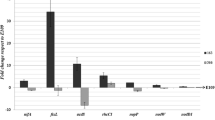Abstract
The comparative symbiotic properties of Rhizobium spp. and Bradyrhizobium spp. strains infecting pigeon pea were evaluated. Bradyrhizobium strains (Cajanus) were found to be superior to Rhizobium strains (Cajanus) and the superiority was ascertained to be due to the higher enzyme activity of the tricarboxylic acid (TCA) cycle in comparison to Rhizobium spp. strains. Moreover, metabolic superiority or rapid growth rate does not necessarily correlate with symbiotic effectiveness. The symbiotic performance of isolates varied with the host cultivar. The dry matter accumulation could be correlated with the total acetylene reduction activities rather than nodule number or nodule fresh weight per plant.
Similar content being viewed by others
Author information
Authors and Affiliations
Additional information
Received: 3 March 1993
Rights and permissions
About this article
Cite this article
Anand, R., Dogra, R. Comparative efficieny of Rhizobium/Bradyrhizobium spp. strains in nodulating Cajanus cajan in relation to characteristic metabolic enzyme activities. Biol Fertil Soils 24, 283–287 (1997). https://doi.org/10.1007/s003740050244
Issue Date:
DOI: https://doi.org/10.1007/s003740050244




